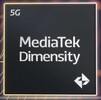Samsung Exynos 1480 vs MediaTek Dimensity 7300X vs MediaTek Dimensity 8100
Samsung Exynos 1480
► remove from comparison
The Samsung Exynos 1480 is a system on a chip (SoC) for mid-range smartphones and tablets based on Android. The CPU is made up of two clusters, each consisting of four cores. Four Cortex-A78 power cores (up to 2.75 GHz) and four Cortex-A55 power cores (up to 2.05 GHz) are used. The integrated graphics unit (GPU) is a Samsung Xclipse 530. The chipset supports Wi-Fi 6E and Bluetooth 5.3. Both LPDDR4x and LPDDR5 can be connected as RAM. UFS 3.1 is possible as internal memory.
The performance of the new AI engine with 6K MAC NPU is said to be around four times higher than its predecessor. In addition, displays with up to 144 Hz and Full HD+ can be used and cameras with up to 200 MPix are supported. The improved ISP now also enables videos in Ultra HD with up to 60 frames per second and is also capable of HDR and zero-shutter lag (ZSL).
The integrated modem has again received a significant speed boost for downloads and is considerably faster for both 5G-Sub6 (download: up to 5.1 GBit/s, upload: up to 1.28 GBit/s) and 5G-mmWave (download: up to 4.84 GBit/s, upload: up to 0.92 GBit/s), but remains unchanged for uploads since the Exynos 1280. There are no changes for LTE (Cat. 18, download: up to 1.2 GBit/s, upload up to 0.211 GBit/s).
The Exynos 1480 is manufactured by Samsung using the 4 nm process (Samsung 4LPP).
MediaTek Dimensity 7300X
► remove from comparison
The MediaTek Dimensity 7300 is an ARM-based mid-range SoC for (mostly Android based) smartphones. The integrated CPU is divided into two clusters with four larger ARM Cortex-A78 cores with up to 2.5 GHz clock speed and an efficiency cluster with four ARM Cortex-A55 cores with up to 2 GHz. Compared to the Dimensity 7300, the 7300X is intended for devices for multiple displays like foldable smartphones.
In addition to the integrated ARM Mali-G615 MC2 iGPU, the 7300 also offers a MediaTek APU 655 for AI tasks. Furthermore, a 5G multi-mode modem is installed (2G - 5G) with up to 3.27 Gbps download speed. In addition to Wi-Fi 6E, Bluetooth 5.4 is also supported.
The chip is manufactured using the modern 4nm process and is advertised to consume 25% less power compared to the older Dimensity 7050.
MediaTek Dimensity 8100
► remove from comparison
The Mediatek Dimensity 8100 is a upper mid-range smartphone SoC. The CPU integrates four fast ARM Cortex-A78 cores with up to 2.85 GHz and four efficient Cortex-A55 cores with up to 2 GHz. The integrated 5G modem supports all modern standards including 5G SA and a maximum download speed of 4.7 Gbps.
The integrated ARM Mali-G610 MC6 GPU integrates 6 cores and supports displays with up to 2,960 x 1,440 pixels (WQHD+).
The chip is produced at TSMC in 5nm.
| Model | Samsung Exynos 1480 | MediaTek Dimensity 7300X | MediaTek Dimensity 8100 | ||||||||||||
| Codename | ARM Cortex-A55 / A78 | Cortex-A78 / A55 | Cortex-A78 / A55 | ||||||||||||
| Series | Samsung Exynos | ||||||||||||||
| Series: Exynos ARM Cortex-A55 / A78 |
| ||||||||||||||
| Clock | 2050 - 2750 MHz | 2000 - 2500 MHz | 2000 - 2850 MHz | ||||||||||||
| Cores / Threads | 8 / 8 4 x 2.8 GHz ARM Cortex-A78 4 x 2.1 GHz ARM Cortex-A55 | 8 / 8 4 x 2.5 GHz ARM Cortex-A78 4 x 2.0 GHz ARM Cortex-A55 | 8 / 8 | ||||||||||||
| Technology | 4 nm | 4 nm | 6 nm | ||||||||||||
| Features | 6K MAC NPU, Wi-Fi 6E, Bluetooth 5.3, GNSS (GPS, Glonass, BeiDou, Galileo) | 4x ARM Cortex-A77 (2.85 GHz), 4x ARM Cortex-A55 (2 GHz), ARM Mali-G610 MC6, APU 580, 5G Modem, MiraVision 780, Wi-Fi 6E, Bluetooth 5.3, UFS 3.1, LPDDR5 | |||||||||||||
| iGPU | Samsung Xclipse 530 ( - 1300 MHz) | ARM Mali-G615 MP2 | ARM Mali-G610 MP6 | ||||||||||||
| Architecture | ARM | ARM | ARM | ||||||||||||
| Announced | |||||||||||||||
| Manufacturer | semiconductor.samsung.com | www.mediatek.com | www.mediatek.com |
Benchmarks
Average Benchmarks Samsung Exynos 1480 → 100% n=14
Average Benchmarks MediaTek Dimensity 7300X → 113% n=14
Average Benchmarks MediaTek Dimensity 8100 → 125% n=14
* Smaller numbers mean a higher performance
1 This benchmark is not used for the average calculation












